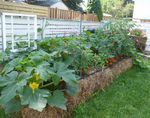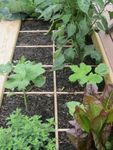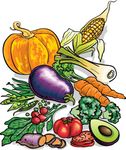January-February 2020 - Swain County Cooperative ...
←
→
Page content transcription
If your browser does not render page correctly, please read the page content below
January-February
2020 876 Skyland Dr. Suite 206
Sylva, N.C. 28779
Newsletter 828-586-4009
jackson.ces.ncsu.edu
Whether we experience a mild or frigid winter, it’s the time of year when many gar-
deners get “twitchy” to do something with their gardens! But for those who have no
space or limited space gardening in “traditional rows” is not an option! In this arti-
cle, I want to encourage readers with sparse soil options to consider gardening with
some of the following “alternative” small gardening practices.
Container gardening is a popular small gardening “alternative” and works wonder-
fully for folks in apartments or if you have a porch or patio and want to have your
vegetables as close to the house as possible. Almost any kind of container is fair
game when growing vegetables, as long as there are drainage holes in the bottom.
Many folks use traditional containers such as a window box or a decorative pot
made of clay or plastic. Over the years, I’ve seen watering cans, bathtubs, wheelbar-
rows, children’s wagons and other such items repurposed into container gardens
that can be quaint and quite imaginative! Always remember to drill holes in the bot-
tom to ensure proper drainage and avoid potential plant root rot from inside.
When choosing the type of soil for your containers, consider using a potting mix
rather than top soil. Be prepared to monitor your plants closely and water more fre-
quently as quite often the soil dries out quicker in containers than soil in the
ground. Eventually you will water everyday once the roots have grown throughout
the container and the temperatures are consistently warmer.
Another interesting method many gardeners have inquired about is straw bale gar-
dening. People wonder how you could possibly grow
anything in a straw bale, but the process is pretty
straight forward. First off, you’ll need bales that
have begun to decompose in the center, so use ei-
ther year-old bales, or condition the bales prior to
planting by watering and adding a heavy nitrogen
fertilizer. It takes about two weeks to properly con-
dition the bales and then you’ll be ready to plant. If
starting seeds, you’ll need to add a few trowels of
compost to the center of the bale before sowing.
Not all plants are ideal for straw bale gardening,
but strawberries, tomatoes, peppers, squash,
pumpkins, cucumbers, watermelon, and zucchini work quite well. Hay bales can
also be used for the same purpose, but be aware that hay bales will generate a lot of
weeds, whereas straw bales are generally less so. Straw bales require more water
and fertilizer than traditional gardens, but are a good “alternative” if you have soil
with poor fertility, disease and or limited space.
Continued on pg 4
Employment and program opportunities are offered to all people regardless of race, color, national origin, sex, age, veteran statues or disability.
North Carolina State University, North Carolina A & T State University, U.S. Department of Agriculture, and local governments cooperating.The term Brambles is commonly used to describe certain members of the rose family which includes plants in the
Genus Rubus that typically have thorns and produce edible fruit. Blackberries and raspberries are the “poster”
berries of the brambles now re-coined “Caneberries.” many of which are native and grow in the wild while others
such as tayberries, loganberries and boysenberries are cultivated for taste, yield or without thorns.
Blackberry varieties are available as either thorny or thornless, while raspberries come in
red, black, purple and yellow colors. Some raspberry varieties are “fall-bearing” produc-
ing fruit in the fall on what are known as primocanes (first year canes). Other raspberry
varieties produce berries in the summer on floricanes (second-year canes). Blackberries
and red raspberries produce many suckers and spread laterally while black raspberries
and purple raspberries generally stay confined to the planted area.
If you desire to start a caneberry patch, then site selection is crucial for success. An ideal location should have
well drained soil, positioned in full sunlight with good air circulation. These aspects will encourage a dry microcli-
mate within the planting to reduce the incidence of fungal disease and increase berry yields. If your spot is clayey
or somewhat wet, then consider building raised beds and adding compost and or various manures as soil amend-
ments. To optimize plant growth, test your soil to determine your soils pH and nutrient levels. Add lime and fer-
tilizer accordingly as caneberries enjoy a soil pH of 5.8 to 6.5. A few extra tips to implement prior to a springtime
planting, is the removal of noxious weeds on site and wild brambles within 600 feet.
When choosing raspberry and blackberry varieties, it’s important to select those that can
withstand winter temperatures common to Western North Carolina. For Jackson and
Swain counties, raspberry varieties that produce as primocanes are Heritage, Carolina,
Autumn Britten and Nantahala. For erect blackberries choose varieties such as Navaho,
Arapaho, Shawnee, Chickasaw and Apache and for semi-erect blackberries choose Black
Satin, Hull or Chester.
When planting caneberries, set plants 1 inch deeper than grown in the nursery and at least 30 inches apart in
rows that are spaced 9 to 10 feet apart between rows. Plant rooted canes early in spring. Do not apply fertilizer at
planting or for several weeks after planting. Caneberries are easily injured by too much fertilizer so apply about 2
pounds of 10-10-10 per 100 linear feet of row the first year and 2-3 lbs. every March in subsequent years.
Trellis
Most caneberries should be grown with some type of trellis. Trellises improve fruit quality, make harvesting eas-
ier, and reduce disease problems. Trellises also make pruning simpler by encouraging new cane growth in the
middle of the row, rather than just along the outside edges. For plants grown in a hedgerow, the “T” or “V” trellis
systems are ideal.
Pruning
Before the buds break in the late winter or early spring, remove all of the old canes that fruited the previous year.
These have gray, peeling bark and branches (dead and won’t fruit again). Remove canes that have emerged out-
side of the desired row width (12-18 inches) and thin out until only four to five canes remain per linear foot.
For blackberries that produce fruit in the summer (floricanes), prune off the tops on 1-year canes when they
reach about 42-48 inches. This encourages laterals, which will bear fruit in the following year. In March, cut the
side laterals back to 12 buds (about 8-12 inches in length). For red raspberries that produce in the fall
(primocanes) cut the canes down to the ground in late fall to early winter & remove all plant waste from the field.
Harvesting
While Raspberries are ready to pick when they easily separate from the receptacle or core, blackberries do not
separate and should be judged by their ripe color and taste. All berries are extremely perishable and should be
harvested frequently. To maintain fresh quality, place fruit in shallow containers, no more than three berries
deep, and cooled to 33°F as quickly as possible. Fruit properly harvested and held at this temperature can main-
tain fresh quality for three to seven days. If the fruit is to be made into jam or jelly, process it immediately, or
freeze it until ready to use.
Page 2Lawns
● Fertilize cool season lawns with a slow-release fertilizer at a rate of ½ to 1 lb.
of nitrogen per 1000 sq. ft.
● If broadleaf weeds are present, pull them while they are small or spot treat
with a broadleaf herbicide.
Vegetables
● Break up soil in garden beds when soil is dry enough.
● Turn under cover crop when soil is not too wet.
● Plant asparagus crowns, radishes and potatoes.
● Start transplants for cool season plants such as broccoli, cabbage, cauliflower,
and kale indoors early in the month.
● Onion seeds for transplants can be sown indoors early this month.
● Sow spinach seed in well-drained soil that was turned over in autumn. Cover
lightly with straw.
● Late in the month, when soil is dry enough to work, begin sowing shelling and
snap peas, snow peas, onions, radishes, and spinach.
Fruits
● Plant fruit trees and blueberry, blackberry, and grape plants now through
April.
● Prune grape vines.
● Spray fruit trees with dormant oil when temperature is above 45 degrees F.
and will remain above freezing for 24 hours. This will help eliminate some
insects by suffocating over-wintering eggs and larvae.
● Spray peach and nectarine trees with a fungicide to prevent leaf curl.
● Order fruit plants from the 4-H club. Order forms are available from the
Extension Office.
Trees Shrubs & Flowers
● Plant trees and shrubs when ground is not frozen.
● Cut back overgrown shrubs. Prune evergreen shrubs lightly. Prune summer-flowering shrubs to
encourage new blooms. Prune shade trees if necessary.
● Spray woody ornamentals with dormant oil.
● Fertilize large shade trees with 3 pounds of 10-10-10 per inch of trunk diame-
ter.
● Watch for signs of frost heaving; firm the soil around heaved plants.
● Fertilize spring-flowering bulbs as soon as the leaves begin to appear if bulbs
were not fertilized in fall. Use 10-10-10, 1 teaspoon per bulb or 4 cups per 200
square feet.
● Trim back ornamental grasses, liriope and mondo grass.
● Order seeds and plants.
Page 3Square foot gardening is a method where vegetables are grown in one-foot by
one-foot squares within a raised bed. Gardeners arrange their beds in multiple
ways, from a single square to as many as sixteen squares arranged four by
four. Within each square, you can grow desired vegetables with the
spacing and plant density in each square varying depending on the
mature size of the vegetable within that square. Large plants, like
tomatoes, peppers and broccoli would have just a single plant per
square, allowing room for each plant to grow to full size. Smaller
plants like beets can be planted up to 16 plants per square, while
plants such as carrots can have 32 per square. As you can see, the
concept behind square foot gardening is to maximize available
space, as opposed to “open” spaces between the rows in traditional
row gardens.
Always remember to be smart and creative when picking which
vegetables to grow! Think vertical as a means to expand your garden as in the
case of stringing up cucumbers. Consider growing both cool and warm season
vegetables, utilize succession planting and tap into the benefits of low tunnels.
Page 4
Christy Bredenkamp,
Area Horticulture Agent
Interim County Extension Director - Macon
Macon County Center
193 Thomas Heights Rd.
Franklin, NC 28734You can also read



























































